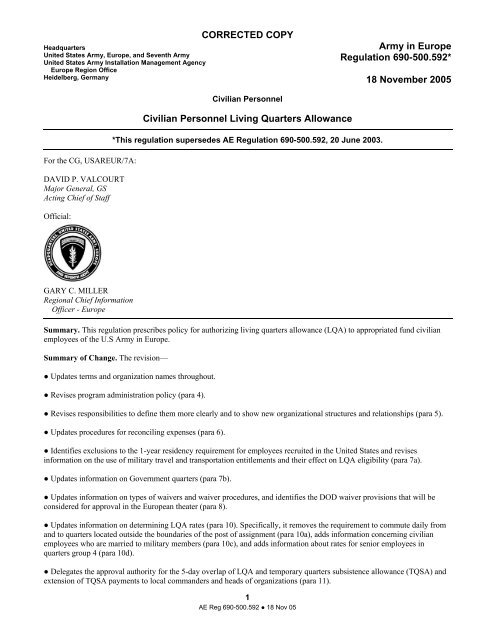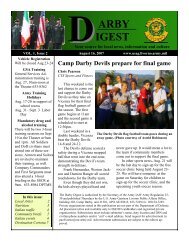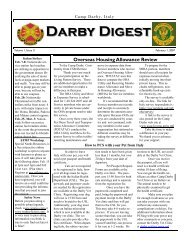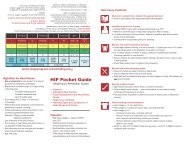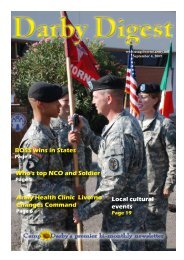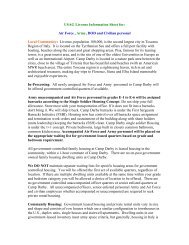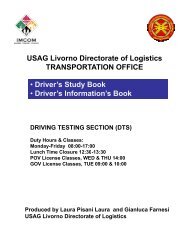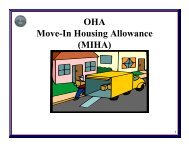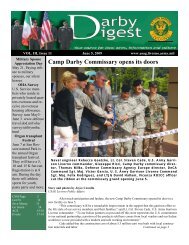Army in Europe Regulation 690-500.592, Civilian ... - U.S. Army
Army in Europe Regulation 690-500.592, Civilian ... - U.S. Army
Army in Europe Regulation 690-500.592, Civilian ... - U.S. Army
- No tags were found...
Create successful ePaper yourself
Turn your PDF publications into a flip-book with our unique Google optimized e-Paper software.
HeadquartersUnited States <strong>Army</strong>, <strong>Europe</strong>, and Seventh <strong>Army</strong>United States <strong>Army</strong> Installation Management Agency<strong>Europe</strong> Region OfficeHeidelberg, GermanyCORRECTED COPY<strong>Army</strong> <strong>in</strong> <strong>Europe</strong><strong>Regulation</strong> <strong>690</strong>-<strong>500.592</strong>*18 November 2005For the CG, USAREUR/7A:DAVID P. VALCOURTMajor General, GSAct<strong>in</strong>g Chief of StaffOfficial:<strong>Civilian</strong> Personnel<strong>Civilian</strong> Personnel Liv<strong>in</strong>g Quarters Allowance*This regulation supersedes AE <strong>Regulation</strong> <strong>690</strong>-<strong>500.592</strong>, 20 June 2003.GARY C. MILLERRegional Chief InformationOfficer - <strong>Europe</strong>Summary. This regulation prescribes policy for authoriz<strong>in</strong>g liv<strong>in</strong>g quarters allowance (LQA) to appropriated fund civilianemployees of the U.S <strong>Army</strong> <strong>in</strong> <strong>Europe</strong>.Summary of Change. The revision—● Updates terms and organization names throughout.● Revises program adm<strong>in</strong>istration policy (para 4).● Revises responsibilities to def<strong>in</strong>e them more clearly and to show new organizational structures and relationships (para 5).● Updates procedures for reconcil<strong>in</strong>g expenses (para 6).● Identifies exclusions to the 1-year residency requirement for employees recruited <strong>in</strong> the United States and revises<strong>in</strong>formation on the use of military travel and transportation entitlements and their effect on LQA eligibility (para 7a).● Updates <strong>in</strong>formation on Government quarters (para 7b).● Updates <strong>in</strong>formation on types of waivers and waiver procedures, and identifies the DOD waiver provisions that will beconsidered for approval <strong>in</strong> the <strong>Europe</strong>an theater (para 8).● Updates <strong>in</strong>formation on determ<strong>in</strong><strong>in</strong>g LQA rates (para 10). Specifically, it removes the requirement to commute daily fromand to quarters located outside the boundaries of the post of assignment (para 10a), adds <strong>in</strong>formation concern<strong>in</strong>g civilianemployees who are married to military members (para 10c), and adds <strong>in</strong>formation about rates for senior employees <strong>in</strong>quarters group 4 (para 10d).● Delegates the approval authority for the 5-day overlap of LQA and temporary quarters subsistence allowance (TQSA) andextension of TQSA payments to local commanders and heads of organizations (para 11).1AE Reg <strong>690</strong>-<strong>500.592</strong> ● 18 Nov 05
CORRECTED COPYApplicability. This regulation applies to U.S. appropriated fund civilian employees who are serviced by the <strong>Civilian</strong> HumanResources Agency, <strong>Europe</strong> Region (CHRA-E), and paid by the Defense F<strong>in</strong>ance and Account<strong>in</strong>g Service unless excludedunder the terms of a civilian personnel-servic<strong>in</strong>g agreement. This regulation does not apply to employees <strong>in</strong> the SeniorExecutive Service. AE <strong>Regulation</strong> 215-3 prescribes policy and procedures for nonappropriated fund (NAF) employees.Supplementation. Organizations will not supplement this regulation without the USAREUR G1 (AEAGA-CE) approval.Forms. AE and higher-level forms are available through the <strong>Army</strong> <strong>in</strong> <strong>Europe</strong> Publish<strong>in</strong>g System (AEPUBS).Records Management. Records created as a result of processes prescribed by this regulation must be identified, ma<strong>in</strong>ta<strong>in</strong>ed,and disposed of accord<strong>in</strong>g to AR 25-400-2. Record titles and descriptions are available on the <strong>Army</strong> Records InformationManagement System website at https://www.arims.army.mil.Suggested Improvements. The proponent of this regulation is the USAREUR G1 (AEAGA-CE, DSN 375-2551). Users maysuggest improvements to this regulation by send<strong>in</strong>g DA Form 2028 to the USAREUR G1 (AEAGA-CE), Unit 29351, APOAE 09014-9351.Distribution. C (AEPUBS).1. Purpose2. References3. Explanation of Abbreviations and Terms4. Program Adm<strong>in</strong>istration5. Responsibilities6. Reconciliation of Expenses7. Eligibility8. Overpayments and Waivers9. Cont<strong>in</strong>u<strong>in</strong>g Eligibility10. Determ<strong>in</strong><strong>in</strong>g LQA Rates11. Other Allowances and ReimbursementsGlossaryCONTENTS1. PURPOSEThis regulation—a. Implements policy for pay<strong>in</strong>g liv<strong>in</strong>g quarters allowance (LQA) to appropriated fund (APF) civilian employees of theU.S. <strong>Army</strong> <strong>in</strong> <strong>Europe</strong>, unless they are excluded under the terms of a civilian personnel servic<strong>in</strong>g agreement. Employeesauthorized LQA must be—(1) Serviced by the <strong>Civilian</strong> Human Resources Agency, <strong>Europe</strong> Region (CHRA-E).(2) Paid by the Defense F<strong>in</strong>ance and Account<strong>in</strong>g Service (DFAS).b. Must be used with the Department of State Standardized <strong>Regulation</strong>s (DSSR) and DOD 1400.25-M, subchapter 1250.2. REFERENCESa. Publications.(1) Jo<strong>in</strong>t Federal Travel <strong>Regulation</strong>s (JFTR), volume 1, Military Members(https://secureapp2.hq.da.pentagon.mil/perdiem/trvl/regs.html).(2) Department of State Standardized <strong>Regulation</strong>s (DSSR) (http://www.state.gov/mla/als/c1843.htm).2AE Reg <strong>690</strong>-<strong>500.592</strong> ● 18 Nov 05
CORRECTED COPY(3) DOD Directive 1404.10, Emergency-Essential (E-E) DOD U.S. Citizen <strong>Civilian</strong> Employees(http://www.dtic.mil/whs/directives/corres/html/1441o.htm).(4) DOD 7000.14-R, Department of Defense F<strong>in</strong>ancial Management <strong>Regulation</strong>s (FMRs)(http://www.dtic.mil/whs/directives/corres/html/700014r.htm).(5) DOD 1400.25-M, subchapter 1250, Overseas Allowance and Differentials(http://www.dtic.mil/whs/directives/corres/html/140025m.htm).(6) AR 25-400-2, The <strong>Army</strong> Records Information Management System (ARIMS).(7) AR <strong>690</strong>-950, Career Management.(8) AE <strong>Regulation</strong> 215-3, Nonappropriated Fund Personnel Policy and Procedures.b. Forms.(1) SF 1190, Foreign Allowances Application, Grant, and Report.(2) DA Form 2028, Recommended Changes to Publications and Blank Forms.3. EXPLANATION OF ABBREVIATIONS AND TERMSThe glossary expla<strong>in</strong>s abbreviations and terms.4. PROGRAM ADMINISTRATIONTo be considered eligible for allowances covered by this regulation, employees must meet the basic eligibility requirementsof DSSR, section 031.11 and section 031.12a and b. DFAS adjusts LQA payments based on fluctuat<strong>in</strong>g currency exchangerates and biweekly rate updates published by the U.S. Department of State.5. RESPONSIBILITIESa. The CHRA-E will—(1) Determ<strong>in</strong>e the employee’s eligibility for LQA before the employee is appo<strong>in</strong>ted.(2) Advise employees about eligibility, entitlements, and submission of required documents.(3) Give employees advice and assistance on how to complete SF 1190.(4) Inform employees of the follow<strong>in</strong>g (<strong>in</strong> writ<strong>in</strong>g):(a) Employees must provide receipts for actual utility expenses no more than 15 months after occupy<strong>in</strong>gpermanent quarters.dates.(b) The utilities portion of LQA payment will be suspended if receipts are not submitted by established suspense(c) CHRA-E may extend suspense dates <strong>in</strong> circumstances beyond the employee’s control.(5) Review the employee’s SF 1190 and receipts for allowances to ensure the form is complete, and forward theform to the <strong>Civilian</strong> Personnel Operations Center (CPOC) for process<strong>in</strong>g.(6) Reconcile LQA expenditures for the first year the employee resides <strong>in</strong> quarters <strong>in</strong> the overseas area accord<strong>in</strong>g toparagraph 6.(7) Review the SF 1190 and receipts for accuracy and completeness and enter the <strong>in</strong>formation from the SF 1190 <strong>in</strong>tothe Defense <strong>Civilian</strong> Personnel Data System.3AE Reg <strong>690</strong>-<strong>500.592</strong> ● 18 Nov 05
CORRECTED COPY(8) On receipt of a request to designate a position as hard-to-fill (glossary), review recruitment records and therequester’s documentation, determ<strong>in</strong>e if criteria are met, and approve or disapprove the request.(9) Keep a list of hard-to-fill positions on the CHRA-E website at http://www.chra.eur.army.mil/, and review the listevery 2 years to ensure the positions still meet the criteria.(10) Send waiver requests, cases that are precedent sett<strong>in</strong>g, and cases where special conditions are met to the <strong>Civilian</strong>Personnel Directorate (CPD), Office of the Deputy Chief of Staff, G1, HQ USAREUR/7A, for f<strong>in</strong>al determ<strong>in</strong>ation.b. The CPD will—(1) Review and make f<strong>in</strong>al determ<strong>in</strong>ations on precedent-sett<strong>in</strong>g requests.(2) Review and make f<strong>in</strong>al determ<strong>in</strong>ations on requests for waivers (para 8).(3) Make eligibility determ<strong>in</strong>ations on <strong>in</strong>dividual cases when special conditions are met.(4) Review and determ<strong>in</strong>e eligibility for separate ma<strong>in</strong>tenance allowance (SMA).(5) Provide guidance on <strong>in</strong>terpretation of this regulation.c. Employees will—(1) Provide copies of their rent or lease agreements to the civilian personnel advisory center (CPAC) with anSF 1190 to <strong>in</strong>itiate a claim for LQA.(2) Provide copies of receipts and an SF 1190 to the CPAC at the end of periods of temporary quarters subsistenceallowance (TQSA).(3) Provide copies of utility bills when required by the CPOC for reconciliations accord<strong>in</strong>g to paragraph 6.(4) Inform the CPAC when significant changes <strong>in</strong> costs or family status occur and when the employee moves to anew residence.(5) Review leave and earn<strong>in</strong>gs statements to ensure pay received is accurate. Employees should immediately notifythe CPAC if there are errors.(6) Make payments on time accord<strong>in</strong>g to the contract with the landlord or property owner. Failure to do so may begrounds for term<strong>in</strong>at<strong>in</strong>g LQA and recoup<strong>in</strong>g the amount of LQA already paid. Nonpayment of obligations documented on SF1190 while draw<strong>in</strong>g LQA may be construed as misuse of LQA. Proven misuse of LQA may result <strong>in</strong> discipl<strong>in</strong>ary actionaga<strong>in</strong>st the employee (<strong>in</strong>clud<strong>in</strong>g separation from Federal service).d. Heads of organizations that believe they have hard-to-fill positions will send a request to designate the position as hardto fill to the CPOC through the servic<strong>in</strong>g CPAC. The request must <strong>in</strong>clude detailed documentation that shows what effortswere made to fill the position and the results of those efforts over the previous 6 months; or the request must <strong>in</strong>dicate that theposition is newly established and has no current recruitment record.6. RECONCILIATION OF EXPENSESa. Mandatory Reconciliation. Employees must submit an <strong>in</strong>itial reconciliation at the end of the first year of the rentalperiod. When utility costs are based on estimates, employees will submit receipts for all utilities to the CPAC at the end ofthe first year, but not later than 15 months, after the grant is <strong>in</strong>itiated. Authorization for the utilities portion of LQA will besuspended if receipts for all utilities have not been received with<strong>in</strong> 15 months. Extensions may be granted for circumstancesbeyond the employee’s control. When receipts for all utilities are submitted, a reconciliation and one-time retroactiveadjustment <strong>in</strong> the grant will be made.4AE Reg <strong>690</strong>-<strong>500.592</strong> ● 18 Nov 05
CORRECTED COPYb. Voluntary Reconciliation. While there are no requirements for reconciliations <strong>in</strong> addition to the <strong>in</strong>itial one described<strong>in</strong> subparagraph a above, employees may request reconciliations whenever they believe that a significant change <strong>in</strong> expenseshas occurred. The purpose of this provision is to correct unusual ga<strong>in</strong>s or losses to the employee. Changes <strong>in</strong> LQA paymentsbased on these reconciliations will be prospective only (affect future payments). In rare cases reconciliations may lead toretroactive reimbursements. A retroactive reimbursement, however, will be limited to the date of the change that caused theover- or underpayment, or no more than 18 months before the date of the submitted claim, whichever is later. The claim mustbe submitted with<strong>in</strong> 60 days after receiv<strong>in</strong>g notification from the utility company or the landlord.7. ELIGIBILITYa. LQA Authorization. LQA is a payment <strong>in</strong>tended to cover substantially all average allowable costs for suitable,adequate lodg<strong>in</strong>g and selected utilities. LQA will be granted for the follow<strong>in</strong>g APF employees:(1) Employees recruited <strong>in</strong> the United States or its possessions for positions at grades GS-09 (or equivalent), WG-11,WL-09, WS-05, and above. This <strong>in</strong>cludes employees selected for entry-level positions with target grades at or above thesegrade levels. Grade restrictions do not apply to applicants selected for hard-to-fill positions or career program positions (AR<strong>690</strong>-950 or appropriate agency career program guidel<strong>in</strong>es) below the GS-09 (or equivalent) level. Employees who previouslyvacated an outside the cont<strong>in</strong>ental United States (OCONUS) civilian or contractor position must have resided permanently <strong>in</strong>the United States for at least 1 year immediately before accept<strong>in</strong>g the formal job offer. This 1-year residency requirementdoes not apply to—(a) Employees serv<strong>in</strong>g on a mandatory mobility agreement.(b) Applicants hired <strong>in</strong>to hard-to-fill positions.(c) Applicants who were civilian or contractor employees serv<strong>in</strong>g overseas <strong>in</strong> an area where family memberswere not authorized on an assignment that provided for their return transportation to the United States.(2) Employees who are recruited from outside the United States or its possessions for positions <strong>in</strong> grades GS-09 (orequivalent), WG-11, WL-09, WS-05, and above. This <strong>in</strong>cludes employees selected for entry-level positions with targetgrades at and above these grade levels. Grade restrictions do not apply to applicants selected for hard-to-fill positions orcareer-program positions below the GS-09 (or equivalent) level. NAF employment will be considered <strong>in</strong> determ<strong>in</strong><strong>in</strong>g“substantially cont<strong>in</strong>uous employment” as long as DSSR provisions are met. Former military members and civilianemployees will be considered to meet the DSSR, section 031.12, eligibility requirement of “substantially cont<strong>in</strong>uousemployment” if they are appo<strong>in</strong>ted with<strong>in</strong> 1 year after the date of separation or when the transportation entitlement is lost,whichever occurs first. Active Reserve duty performed dur<strong>in</strong>g the 1-year period will extend that period by the amount of timeserved. The follow<strong>in</strong>g conditions will not affect LQA eligibility:(a) Shipment of household goods (HHG) from nontemporary storage (NTS).(b) A family member’s early return to the United States or U.S. territories.return.(c) Shipment of HHG to the United States or U.S. territories <strong>in</strong> conjunction with the family member’s early(d) Shipment of a privately owned vehicle (POV) <strong>in</strong> unusual cases (for example, the POV is shipped for use by afamily member). CPD will make eligibility determ<strong>in</strong>ations on an <strong>in</strong>dividual basis.(e) A short-distance HHG move at Government expense (authorized for separat<strong>in</strong>g military members) fromvacated Government quarters to temporary storage or to a temporary residence <strong>in</strong> the vic<strong>in</strong>ity of the vacated quarters. This isa separate Jo<strong>in</strong>t Federal Travel <strong>Regulation</strong>s (JFTR), volume 1, entitlement and does not affect the travel and transportationentitlements authorized on the separation orders.(f) Stor<strong>in</strong>g HHG <strong>in</strong> NTS on separation or retirement from the military. This is a separate JFTR, volume 1,entitlement and does not affect the travel and transportation entitlements authorized on the separation orders.(3) Federal civilian or NAF employees selected for or converted from NAF to positions <strong>in</strong> grades GS-09 (orequivalent), WG-11, WL-09, WS-05, and above; or a position that has an equivalent target grade; a hard-to-fill position; or acareer program position at any grade; who meet all of the follow<strong>in</strong>g:5AE Reg <strong>690</strong>-<strong>500.592</strong> ● 18 Nov 05
CORRECTED COPY(a) Are transferr<strong>in</strong>g to the <strong>Europe</strong>an theater from another overseas Government activity or agency without abreak <strong>in</strong> service.(b) Meet basic eligibility criteria <strong>in</strong> DSSR, section 031.11 or 031.12a and b.(c) Were already receiv<strong>in</strong>g or eligible to receive LQA at the time of selection.b. Government Quarters. The employee will not be eligible to receive LQA for rent<strong>in</strong>g or purchas<strong>in</strong>g privately ownedquarters (POQ) when suitable and fully adequate Government quarters are offered for the duration of the overseas tour andthe employee elects not to accept them. The CPD will <strong>in</strong>form the CHRA-E when Government quarters are available.8. OVERPAYMENTS AND WAIVERSa. Collection of Overpayments. Overpayments of LQA based on an employee’s failure to submit all required receiptswill not be waived locally. Overpayments will be processed for collection by adm<strong>in</strong>istrative offset aga<strong>in</strong>st the employee’scurrent pay account. The employee will have the overpayment deducted from future pay.b. Local Waivers of Erroneous Overpayment of LQA. Employees may request a waiver of a claim aga<strong>in</strong>st them for anerroneously authorized LQA payment only if the employee has documented evidence that proves the overpayment was basedon an erroneous eligibility determ<strong>in</strong>ation and there is no <strong>in</strong>dication of fraud, misrepresentation, fault, or lack of good faith onthe part of the employee. The waiver may be granted only when the deficiency that led to the erroneous payment is based onrequirements <strong>in</strong> this regulation that are <strong>in</strong> addition to those <strong>in</strong> the DSSR, and there is no <strong>in</strong>dication of fraud,misrepresentation, fault, or lack of good faith on the part of the employee.c. Head of Agency Waivers. Waiver requests for overpayments of authorized allowances, and waivers of unauthorizedallowances based on eligibility factors that are not locally governed (those under DOD 7000.14-R, vol 8, para 80306) may besubmitted through the supervisor and CHRA-E to the USAREUR G1 (AEAGA-CE), Unit 29351, APO AE 09014-9351. TheCPD will review claims and forward them with appropriate recommendations to the decision-mak<strong>in</strong>g authority.d. DOD Waiver Provisions.(1) The provisions of DOD 1400.25-M, subchapter 1250, paragraph 5.1.1.2.2, which delegates waiver-approvalauthority to major commands, will be exercised <strong>in</strong> the follow<strong>in</strong>g situations:(a) The sponsor<strong>in</strong>g spouse dies (para 5.1.1.2.2.1).(b) The sponsor<strong>in</strong>g spouse becomes physically or mentally <strong>in</strong>capable of cont<strong>in</strong>ued employment with theGovernment (para 5.1.1.2.2.2).(c) The sponsor<strong>in</strong>g spouse left the post or area permanently (para 5.1.1.2.2.4).(d) Spouses could not ma<strong>in</strong>ta<strong>in</strong> a common dwell<strong>in</strong>g because of the relocation of either spouse’s workplace(para 5.1.1.2.2.5).(e) The employee is an <strong>in</strong>cumbent of a position designated as emergency-essential and is serv<strong>in</strong>g <strong>in</strong> a deployedtheater accord<strong>in</strong>g to DOD Directive 1404.10 (para 5.1.1.2.2.6).(2) The restrictions of correspond<strong>in</strong>g provisions outl<strong>in</strong>ed <strong>in</strong> DOD 1400.25-M, subchapter 1250, paragraph 5.1.1.2.2,will be applied and employees must meet the requirements of this regulation (AE Reg <strong>690</strong>-<strong>500.592</strong>).(3) Employees may submit waiver requests and required documentation through their supervisor and CHRA-E to theUSAREUR G1 (AEAGA-CE), Unit 29351, APO AE 09014-9351. Eligibility determ<strong>in</strong>ations will be made on an <strong>in</strong>dividualbasis.9. CONTINUING ELIGIBILITYUnless otherwise prescribed, all employees who met the eligibility criteria <strong>in</strong> prevail<strong>in</strong>g regulations at the time ofappo<strong>in</strong>tment but who do not meet the criteria of this regulation will cont<strong>in</strong>ue to receive LQA. Additionally, if an employee isreceiv<strong>in</strong>g LQA based on occupy<strong>in</strong>g a hard-to-fill position and leaves that position, the employee’s LQA will cont<strong>in</strong>ue. LQA<strong>in</strong> such cases will cont<strong>in</strong>ue as long as the employee rema<strong>in</strong>s employed <strong>in</strong> a position covered by this regulation without abreak of service of more than 3 calendar days. This provision—6AE Reg <strong>690</strong>-<strong>500.592</strong> ● 18 Nov 05
CORRECTED COPYa. Does not apply to certa<strong>in</strong> former NAF employees who received LQA based solely on a local commander’s waiverauthority. These employees reta<strong>in</strong>ed the allowance on employment <strong>in</strong> an APF position, but did not meet the eligibilityrequirement of the DSSR and DOD regulations and subsequently had LQA term<strong>in</strong>ated as mandated by the Fiscal Year 1996Authorization Act.b. Will not extend or re<strong>in</strong>state payment of LQA when law, regulation, or policy directed term<strong>in</strong>ation of payment.10. DETERMINING LQA RATESMaximum LQA rates are issued and periodically updated by the Department of State.a. Post of Assignment. The amount of entitlement is based on the employee’s post of assignment, grade, and number offamily members resid<strong>in</strong>g with the employee. An employee who ma<strong>in</strong>ta<strong>in</strong>s and lives <strong>in</strong> quarters outside the boundary of his orher official post of assignment will be granted the LQA rate appropriate to the specific post of assignment. When anemployee ma<strong>in</strong>ta<strong>in</strong>s more than one residence <strong>in</strong> the overseas area, he or she may properly submit expenses for LQAreimbursement for whichever residence the employee designates as primary.b. LQA for Inherited Quarters. LQA for an <strong>in</strong>herited POQ is restricted to reimbursement of actual costs <strong>in</strong>curred.c. LQA for <strong>Civilian</strong> Employees Married to a Military Member. The military member receives basic allowance forhous<strong>in</strong>g (BAH) accord<strong>in</strong>g to established payment of BAH at the “with dependent” or “without dependent” rate as applicable.The civilian spouse of a military member must provide evidence of the military member’s allowance entitlement before adeterm<strong>in</strong>ation of “with family” or “without family” rate of LQA will be made. With proof of the military member’sallowance claim, the spouse will be granted LQA accord<strong>in</strong>g to DSSR, section 134.13c.d. Rates for Senior Employees <strong>in</strong> Quarters Group 4. Employees def<strong>in</strong>ed <strong>in</strong> DSSR, section 135.5c, who are <strong>in</strong> quartersgroup 4 and have 15 years of U.S. Government service will be placed <strong>in</strong> quarters group 3. Government service <strong>in</strong>cludesFederal civilian, NAF, and military service.11. OTHER ALLOWANCES AND REIMBURSEMENTSa. TQSA. TQSA is authorized for newly appo<strong>in</strong>ted or transferred employees who are eligible for LQA. It is <strong>in</strong>tended tocover the reasonable cost of quarters, meals, and laundry expenses <strong>in</strong>curred by the employee and family members for up to90 days after arriv<strong>in</strong>g <strong>in</strong> the overseas area or new post of assignment and up to 30 days immediately before f<strong>in</strong>al departurefrom the post of assignment. The amount of TQSA payable is a percentage of the per diem rate applicable to the post ofassignment or actual cost, whichever is less. The DSSR establishes per diem rates and percentage payable.(1) Local commanders and heads of organizations are authorized to approve an additional period of up to 60 days ofTQSA for compell<strong>in</strong>g reasons beyond the employee’s control. The SF 1190 will be processed by the CHRA-E.Documentation of the reasons must be placed <strong>in</strong> the TQSA file.(2) If the employee has not secured permanent quarters when arrival TQSA ends, LQA will replace TQSA at the rateapplicable to the post of assignment.(3) Local commanders and heads of organizations are authorized to approve simultaneous payment of LQA andTQSA for up to 5 days after residence quarters are vacated to meet heavy clean<strong>in</strong>g or repair requirements imposed by therental agreement. In these cases the CHRA-E will prepare the SF 1190.b. Foreign Transfer Allowance (FTA).(1) Requests for extension of a 10-day predeparture subsistence expense must be submitted to the USAREUR G1(AEAGA-CE), Unit 29351, APO AE 09014-9351, for determ<strong>in</strong>ation.(2) The CHRA-E will determ<strong>in</strong>e eligibility for the lease-penalty expense portion of FTA accord<strong>in</strong>g to the DSSR,section 242.4.c. SMA. Requests for <strong>in</strong>voluntary and voluntary SMA must be sent to the USAREUR G1 (AEAGA-CE), Unit 29351,APO AE 09014-9351, for determ<strong>in</strong>ation.7AE Reg <strong>690</strong>-<strong>500.592</strong> ● 18 Nov 05
CORRECTED COPY(1) Involuntary SMA will be granted when an employee is compelled to ma<strong>in</strong>ta<strong>in</strong> family members somewhere otherthan at the post of assignment because of adverse, dangerous, or notably unhealthy conditions.(2) Voluntary SMA will be granted only for one the follow<strong>in</strong>g reasons:(a) A short-term transitional situation based on school attendance of the employee’s child at the time of theemployee’s transfer. These requests may be approved for the completion of the semester. If the child is a high-school senior,SMA will be approved for the entire schoolyear. In this situation, children must be under the age of 18 or <strong>in</strong>capable of selfsupport,unless they are attend<strong>in</strong>g secondary school.(b) Periods based on medical conditions of a family member. These requests must <strong>in</strong>clude completedocumentation of the family member’s medical condition.8AE Reg <strong>690</strong>-<strong>500.592</strong> ● 18 Nov 05
GLOSSARYCORRECTED COPYSECTION IABBREVIATIONSAEAPFBAHCHRA-ECPACCPDCPOCDADFASDODDSSRFTAHHGHQ USAREUR/7AJFTRLQANAFNTSOCONUSPOQPOVSFSMATQSAUSAREUR<strong>Army</strong> <strong>in</strong> <strong>Europe</strong>appropriated fundbasic allowance for hous<strong>in</strong>g<strong>Civilian</strong> Human Resources Agency, <strong>Europe</strong> Regioncivilian personnel advisory center<strong>Civilian</strong> Personnel Directorate, Office of the Deputy Chief of Staff, G1, Headquarters, United States<strong>Army</strong>, <strong>Europe</strong>, and Seventh <strong>Army</strong><strong>Civilian</strong> Personnel Operations CenterDepartment of the <strong>Army</strong>Defense F<strong>in</strong>ance and Account<strong>in</strong>g ServiceDepartment of DefenseDepartment of State Standardized <strong>Regulation</strong>sforeign transfer allowancehousehold goodsHeadquarters, United States <strong>Army</strong>, <strong>Europe</strong>, and Seventh <strong>Army</strong>Jo<strong>in</strong>t Federal Travel <strong>Regulation</strong>sliv<strong>in</strong>g quarters allowancenonappropriated fundnontemporary storageoutside the cont<strong>in</strong>ental United Statesprivately owned quartersprivately owned vehiclestandard formseparate ma<strong>in</strong>tenance allowancetemporary quarters subsistence allowanceUnited States <strong>Army</strong>, <strong>Europe</strong>SECTION IITERMSappo<strong>in</strong>tedFor purposes of this regulation, an <strong>in</strong>itial appo<strong>in</strong>tment or any type of permanent placement action follow<strong>in</strong>g the <strong>in</strong>itialappo<strong>in</strong>tment with<strong>in</strong> the first year after separation from military service or civilian (Government or contractor) employment.hard-to-fill positionPositions validated and approved by CHRA-E <strong>in</strong> coord<strong>in</strong>ation with organizational leadership that require employees withunique skills, knowledge, or abilities. These positions usually have a documented 6-month recruitment history that showshow hard it is to f<strong>in</strong>d qualified employee candidates with<strong>in</strong> a broad area of consideration. If positions are newly created orhave no current recruitment record, the CHRA-E will use documentation from similar positions <strong>in</strong> similar locations toevaluate the positions.physical residencyFor the purpose of determ<strong>in</strong><strong>in</strong>g local-hire status, physical residence is the actual permanent presence of an applicant overseasfor more than merely a transitory or tourist purpose, regardless of the applicant’s home of record or legal residence.Applicants recruited from the United States who were present overseas based on orders for unaccompanied assignments thatprovided for their return transportation to the United States will be considered to be permanently resid<strong>in</strong>g <strong>in</strong> the United Statesfor eligibility purposes. The time spent overseas under such conditions will be viewed as physical presence <strong>in</strong> the UnitedStates, and the time will count toward meet<strong>in</strong>g the residence requirement.9AE Reg <strong>690</strong>-<strong>500.592</strong> ● 18 Nov 05


